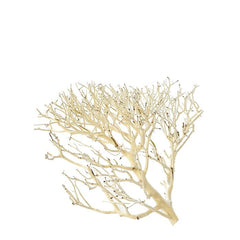
Are you ready to create a miniature underwater world right in your own home? In this comprehensive guide, we will take you through the step-by-step process of setting up a nano aquarium fish tank that will leave you and your guests in awe. Whether you're a seasoned hobbyist or a complete beginner, this guide has got you covered.
From choosing the perfect tank size and selecting the right equipment to creating stunning aquascapes and providing proper care for your fishy friends, we'll walk you through every detail. We understand that setting up a nano aquarium can be overwhelming, but fear not! Our easy-to-follow instructions will demystify the process, allowing you to dive headfirst into the world of underwater ecosystems with confidence.
Let's dive right in and create your very own awe-inspiring nano aquarium fish tank!
Benefits of setting up a nano aquarium fish tank
Nano aquariums have become increasingly popular in recent years, and for good reason. These compact underwater ecosystems offer a world of benefits that make them an attractive option for both novice and experienced aquarists. One of the primary advantages of setting up a nano aquarium is the ability to create a stunning visual centerpiece in your home or office.
Despite their small size, nano aquariums can be transformed into breathtaking displays that showcase the beauty of aquatic life. With careful planning and attention to detail, you can create a captivating aquascape. Whether you choose to showcase vibrant tropical fish, aquatic plants, or a combination of both, a well-designed nano aquarium can be a true work of art. Shop our range of fish tanks, nano's and complete aquarium setups here.
Another significant benefit of setting up a nano aquarium is the opportunity to explore the fascinating world of aquatic ecosystems on a smaller scale. Nano aquariums allow you to closely observe the intricate interactions between different species, the dynamic role of plants in maintaining water quality, and the overall balance of a thriving underwater habitat. This hands-on experience can be incredibly rewarding, as it deepens your understanding and appreciation for the delicate balance of nature. For more Aquascaping ideas, read our blog, Beginner's Guide: Step-by-Step Tips for Designing an Aquascape with Aquarium Plants.
Choosing the right location for your nano aquarium
 When it comes to setting up a nano aquarium, the location you choose can have a significant impact on the success and longevity of your aquatic ecosystem. Selecting the right spot is crucial, as it can affect factors such as lighting, temperature, and accessibility.
When it comes to setting up a nano aquarium, the location you choose can have a significant impact on the success and longevity of your aquatic ecosystem. Selecting the right spot is crucial, as it can affect factors such as lighting, temperature, and accessibility.
One of the most important considerations when choosing a location for your nano aquarium is the availability of natural light. Ideally, you want to place your tank in an area that receives moderate, indirect sunlight throughout the day. Direct sunlight can cause algae growth and fluctuations in water temperature, which can be detrimental to the health of your aquatic inhabitants.
Additionally, it's important to choose a location that is easily accessible, allowing you to perform regular maintenance tasks with ease. Consider the purpose of your nano tank as well, are you looking to keep it on a desktop, bedside table or as a feature aquarium in a living room?
Another factor to consider is the proximity to electrical outlets and water sources. Placing your nano aquarium near a power source and a sink or faucet will make it easier to set up the necessary equipment, such as the filtration system and water change supplies. This convenience can save you time and effort during the maintenance process.
By carefully selecting the right location for your nano aquarium, you can create the ideal environment for your aquatic life to thrive, while also ensuring that the tank is a visually appealing and easily maintainable feature in your home or office.
Selecting the right fish and plant species for a nano aquarium
 When it comes to stocking a nano aquarium, the selection of fish and plant species is crucial to the overall success and balance of your underwater ecosystem. With the limited space available in a nano tank, it's essential to choose species that are well-suited to the confined environment and can coexist harmoniously.
When it comes to stocking a nano aquarium, the selection of fish and plant species is crucial to the overall success and balance of your underwater ecosystem. With the limited space available in a nano tank, it's essential to choose species that are well-suited to the confined environment and can coexist harmoniously.
One of the most important considerations when selecting fish for a nano aquarium is the adult size of the species. It's crucial to choose fish that will not outgrow the tank as they mature. Small, peaceful fish such as tetras, rasboras, and dwarf corydoras are excellent choices for nano aquariums, as they thrive in the confined space and are less likely to become aggressive or territorial. Our knowledgable staff can advise you on what fish will suit your fish tank setup.
In addition to fish, the selection of aquatic plants is equally important in a nano aquarium. Plants not only add visual interest and depth to your aquascape but also play a vital role in maintaining water quality and providing hiding spots for your fish. When choosing plants, opt for species that are known to be hardy and adaptable to the specific lighting and water conditions in your nano tank. Some excellent options include Java moss, Anubias, and dwarf hairgrass, which can create a lush and thriving underwater landscape.
It's also crucial to consider the compatibility of your fish and plant species. Some fish, such as certain cichlids or aggressive tetras, may uproot or consume certain types of plants, disrupting the delicate balance of your aquarium. By carefully researching and selecting compatible species, you can create a harmonious and visually stunning nano aquarium that will thrive for years to come.
Setting up the equipment for your nano aquarium
Setting up the right equipment for your nano aquarium is essential for maintaining the health and stability of your underwater ecosystem. While the size of a nano tank may seem small, the selection and installation of the necessary equipment can significantly impact the success of your aquarium.
One of the most crucial components of a nano aquarium setup is the filtration system. Since nano tanks have a limited water volume, it's essential to choose a high-quality filter that can efficiently remove waste, regulate water flow, and maintain optimal water quality. Hang-on-back (HOB) filters or small internal filters are popular choices for nano aquariums, as they provide reliable filtration without taking up too much space.
Lighting is another critical element in a nano aquarium setup. Proper lighting is essential for the growth and health of aquatic plants, as well as the overall aesthetics of your underwater landscape. Depending on the plant species you choose, you may require a specific type of lighting, such as LED or fluorescent bulbs. It's important to research the lighting requirements for your selected plants and choose a system that can provide the appropriate intensity and spectrum.
 In addition to filtration and lighting, you'll also need to consider equipment for water movement, heating, and substrate. Depending on the size and complexity of your nano aquarium, you may need to install a small powerhead or circulation pump to ensure adequate water flow, a heater to maintain the ideal water temperature, and a suitable substrate, such as gravel or sand, to support plant growth and provide a natural aesthetic.
In addition to filtration and lighting, you'll also need to consider equipment for water movement, heating, and substrate. Depending on the size and complexity of your nano aquarium, you may need to install a small powerhead or circulation pump to ensure adequate water flow, a heater to maintain the ideal water temperature, and a suitable substrate, such as gravel or sand, to support plant growth and provide a natural aesthetic.
By carefully selecting and setting up the right equipment for your nano aquarium, you can create a thriving and visually stunning underwater ecosystem that will captivate you and your guests for years to come.
Step-by-step instructions for setting up a nano aquarium fish tank
Setting up a nano aquarium fish tank can be an exciting and rewarding process, but it's important to follow a systematic approach to ensure the success and longevity of your underwater ecosystem. In this section, we'll guide you through the step-by-step instructions for setting up your nano aquarium fish tank.
- Choose the right tank size: The first step in setting up a nano aquarium is to select the appropriate tank size. Nano aquariums typically range from 2-36L. Consider the space you have available, the number of fish you plan to keep, and the overall design you want to achieve.
- Prepare the tank: Once you un box your new aquarium fish tank, give it a rinse out before your start the set up.
- Add the substrate: Choose a suitable substrate for your nano aquarium, such as gravel, sand, or a specialised aquarium substrate. Again, rinse the substrate or gravel under tap water, you may need to use a fine kitchen colander to do this. Spread the substrate evenly across the bottom of the tank, ensuring that it is at least 6cm deep.
- Install the equipment: Begin setting up the necessary equipment, such as the filtration system, heater, and lighting. Carefully follow the manufacturer's instructions for each piece of equipment, ensuring that they are properly installed and functioning correctly.
- Cycle the aquarium or use a bacterial solution: Before adding any fish or
 plants, it's essential to cycle the aquarium. This is a traditional process that allows the beneficial bacteria to establish in the tank, which is crucial for maintaining water quality and the overall health of your aquatic ecosystem. Follow the recommended cycling process, which may take several weeks to complete. Alternatively, you can add aquarium water conditioners and add beneficial bacterias immediately to your fish tank water.
plants, it's essential to cycle the aquarium. This is a traditional process that allows the beneficial bacteria to establish in the tank, which is crucial for maintaining water quality and the overall health of your aquatic ecosystem. Follow the recommended cycling process, which may take several weeks to complete. Alternatively, you can add aquarium water conditioners and add beneficial bacterias immediately to your fish tank water.
- Introduce plants and decor: Once the tank is cycled, you can begin adding your chosen aquatic plants and decorations. Carefully plant the vegetation, ensuring that they are securely rooted in the substrate. Arrange the decor, such as rocks, driftwood, or ornaments, to create a visually appealing and natural-looking aquascape.
- Add fish: After the plants and decor are in place, you can start introducing your selected fish species. Carefully acclimate the fish to the new environment and monitor them closely for the first few days to ensure they are adapting well.
- Maintain water quality: Regularly monitor and maintain the water quality in your nano aquarium by performing partial water changes, testing for essential parameters, and addressing any issues promptly.
By following these step-by-step instructions, you can set up a thriving and visually stunning nano aquarium fish tank that will provide you with years of enjoyment and fascination.
Maintaining water quality in a nano aquarium
 Maintaining water quality is crucial for the long-term success and health of your nano aquarium. Due to the limited water volume in a nano tank, any fluctuations or imbalances in water parameters can have a significant impact on the aquatic inhabitants. Regularly monitoring and addressing water quality issues is essential to ensure the well-being of your fish and plants.
Maintaining water quality is crucial for the long-term success and health of your nano aquarium. Due to the limited water volume in a nano tank, any fluctuations or imbalances in water parameters can have a significant impact on the aquatic inhabitants. Regularly monitoring and addressing water quality issues is essential to ensure the well-being of your fish and plants.
One of the primary ways to maintain water quality in a nano aquarium is through frequent partial water changes. Depending on the size of your tank and the bioload (the amount of waste produced by the fish and plants), you may need to perform water changes as often as once a week or every two weeks. During these water changes, be sure to use a dechlorinator to remove any harmful chemicals, such as chlorine or heavy metals, from the new water being added.
In addition to water changes, it's important to closely monitor and maintain the appropriate levels of essential water parameters, such as pH, ammonia, nitrites, and nitrates. Invest in a reliable test kit that allows you to regularly check these parameters and make any necessary adjustments. If you notice any significant fluctuations or imbalances, address them promptly to prevent the buildup of harmful compounds that can be detrimental to your aquatic life.
Another crucial aspect of maintaining water quality in a nano aquarium is the proper functioning of the filtration system. Ensure that your filter is regularly cleaned and maintained according to the manufacturer's instructions. This will help to remove accumulated debris and waste, preventing the buildup of organic matter that can lead to water quality issues.
proper functioning of the filtration system. Ensure that your filter is regularly cleaned and maintained according to the manufacturer's instructions. This will help to remove accumulated debris and waste, preventing the buildup of organic matter that can lead to water quality issues.
By diligently monitoring and maintaining the water quality in your nano aquarium, you can create a thriving and healthy underwater ecosystem that will provide you with years of enjoyment and fascination. Remember, the key to success in a nano tank is staying on top of water quality and addressing any problems as soon as they arise.
Tips for creating stunning underwater aquascapes in a nano aquarium
 One of the most rewarding aspects of setting up a nano aquarium is the opportunity to create a visually stunning underwater landscape, known as an aquascape. Aquascaping in a nano tank requires a keen eye for detail and a deep understanding of the principles of design, but the results can be truly breathtaking.
One of the most rewarding aspects of setting up a nano aquarium is the opportunity to create a visually stunning underwater landscape, known as an aquascape. Aquascaping in a nano tank requires a keen eye for detail and a deep understanding of the principles of design, but the results can be truly breathtaking.
When it comes to creating a stunning aquascape in a nano aquarium, the first step is to establish a clear vision and design concept. Consider the overall aesthetic you want to achieve, whether it's a lush, natural-looking environment or a more minimalist, contemporary style. This will help guide your selection of plants, hardscape materials, and the overall layout of your aquarium.
One of the key principles of aquascaping in a nano tank is the use of scale and proportion. Since the space is limited, it's important to choose plants and decor that are appropriately sized for the tank, creating a harmonious and balanced composition. Avoid using overly large or bulky elements, as they can overwhelm the small space and make the aquarium appear cluttered.
 Another important consideration when creating an aquascape in a nano tank is the use of depth and layering. By strategically placing taller plants in the back and gradually transitioning to shorter species in the front, you can create the illusion of depth and add visual interest to your underwater landscape. Incorporating different textures, shapes, and colors of plants can also enhance the overall aesthetic and create a sense of depth.
Another important consideration when creating an aquascape in a nano tank is the use of depth and layering. By strategically placing taller plants in the back and gradually transitioning to shorter species in the front, you can create the illusion of depth and add visual interest to your underwater landscape. Incorporating different textures, shapes, and colors of plants can also enhance the overall aesthetic and create a sense of depth.
When it comes to hardscape materials, such as rocks, driftwood, or decorative elements, it's important to choose pieces that complement the overall design and provide visual interest without dominating the space. Arrange these elements in a way that creates a natural-looking, asymmetrical composition, avoiding overly symmetrical or rigid layouts.
By carefully considering the principles of aquascaping and experimenting with different design elements, you can transform your nano aquarium into a mesmerising underwater masterpiece that will captivate the attention of all who behold it. With patience, creativity, and a keen eye for detail, you can create a truly stunning aquascape that showcases the beauty of the natural world. Learn more here about aquascaping design principles, styles and inspiration, From Ordinary to Extraordinary: How to Enhance Your Aquarium with Rocks, Driftwood, and Substrate Aquascaping Techniques.
Troubleshooting common issues in a nano aquarium
While nano aquariums can be incredibly rewarding to set up and maintain, they can also present unique challenges that require prompt attention and troubleshooting. In this section, we'll explore some of the most common issues that may arise in a nano aquarium and provide strategies for addressing them.
One of the most common problems in a nano aquarium is fluctuations in water quality. Due to the limited water volume, any imbalance in parameters such as pH, ammonia, nitrites, or nitrates can quickly become amplified and detrimental to the health of your aquatic inhabitants. To address these issues, it's essential to regularly test the water, perform timely partial water changes, and make any necessary adjustments to maintain optimal water quality.
Another common challenge in nano aquariums is the risk of algae growth. The small water volume and high light exposure can create an environment that is conducive to the rapid growth of algae, which can quickly overtake the tank and obscure the view of your underwater landscape. To combat this, you can try strategies such as reducing the duration of lighting, introducing algae-eating species, and regularly cleaning the glass and decor to remove any buildup.
Overcrowding is another potential issue in nano aquariums, as the limited space can quickly become overwhelmed by an excessive number of fish or plants. This can lead to a variety of problems, including increased waste production, competition for resources, and stress among the aquatic inhabitants. To avoid overcrowding, be sure to carefully research the recommended stocking densities for your chosen species and adhere to them strictly.
Finally, equipment failure can also be a concern in a nano aquarium, as the small size and limited space can make it challenging to accommodate and maintain certain types of equipment. Regular maintenance and monitoring of your filtration system, heater, and other critical components are essential to prevent unexpected breakdowns or malfunctions that could jeopardise the health of your aquarium.
By being proactive in addressing these common issues and implementing preventative measures, you can ensure the long-term success and enjoyment of your nano aquarium. Remember, the key to overcoming challenges in a nano tank is to stay vigilant, act quickly, and continuously adapt to the needs of your unique underwater ecosystem.
Setting up a nano aquarium fish tank can be an incredibly rewarding and captivating hobby. By following the step-by-step instructions and guidelines outlined in this comprehensive guide, you can create a stunning underwater masterpiece that will captivate you and your guests for years to come.
From choosing the right location and selecting the appropriate fish and plant species to setting up the necessary equipment and maintaining water quality, we've covered all the essential aspects of nano aquarium setup and care. By applying the principles of aquascaping, you can transform your nano tank into a visually stunning display that showcases the beauty of nature.
Remember, the key to success in a nano aquarium is to stay vigilant, address any issues promptly, and continuously adapt to the needs of your unique underwater ecosystem. With patience, dedication, and a touch of creativity, you can create a thriving and mesmerising nano aquarium that will bring endless joy and fascination to your life.
So, what are you waiting for? Dive into the world of nano aquariums and unleash your inner aquatic artist.
© weknowpets 2024





